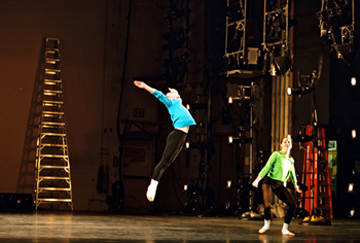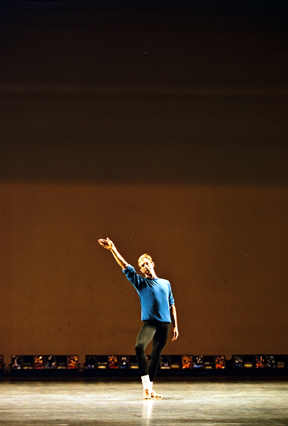HOW TO....
The Merce Cunningham Dance Company will perform “How to Pass, Kick, Fall, and Run” on the opening night program of C ity Center's Fall for Dance Festival (September 28th).
By
Nancy Dalva
copyright
© 2004 by Nancy Dalva
published September 27, 2004
 In
the past year, The Merce Cunningham Dance Company has performed “How
to Pass, Kick, Fall, and Run” in, among other cities, Chicago and
Washington D. C., and it is the final work on the opening night program
of the Fall for Dance Festival on September 28th at City Center in New
York. Dance Theatre of Harlem, Bill T. Jones/Arnie Zane Dance Company,
STREB, and David Neuman will precede the company on the mixed bill. As
it happens, Mr. Jones is an admirer of Mr. Cunningham’s work, as
is Elizabeth Streb. She was in turn admired early on in her career by
John Cage and Mr. Cunningham—who recommended her work to me in the
early 1980s—so the program makes a certain amount of sense as something
other than a random sampler. Besides, “How To” is the only
work in the Cunningham repertory in which the choreographer himself still
takes a part, and it is nice to think of him being on stage again at City
Center, where his company for so many years performed every spring.
In
the past year, The Merce Cunningham Dance Company has performed “How
to Pass, Kick, Fall, and Run” in, among other cities, Chicago and
Washington D. C., and it is the final work on the opening night program
of the Fall for Dance Festival on September 28th at City Center in New
York. Dance Theatre of Harlem, Bill T. Jones/Arnie Zane Dance Company,
STREB, and David Neuman will precede the company on the mixed bill. As
it happens, Mr. Jones is an admirer of Mr. Cunningham’s work, as
is Elizabeth Streb. She was in turn admired early on in her career by
John Cage and Mr. Cunningham—who recommended her work to me in the
early 1980s—so the program makes a certain amount of sense as something
other than a random sampler. Besides, “How To” is the only
work in the Cunningham repertory in which the choreographer himself still
takes a part, and it is nice to think of him being on stage again at City
Center, where his company for so many years performed every spring.
Mr. Cunningham made “How To Pass, Kick, Fall, and Run” in
1965, with the premiere being given in Chicago on November 24th. In the
cast (as noted by David Vaughan in “Merce Cunningham: Fifty Years,”
published by Aperture ) were Carolyn Brown, Barbara Dilley Lloyd, Sandra
Neels, Albert Reid, Peter Saul, Valda Setterfield, and Gus Solomons, Jr.
(The choreographer later added a part for a fifth woman, which has recently
been dropped.) Mr. Cunningham appears today not in his original part,
which is danced by Robert Swinston, but in the part of Mr. Cage, who devised
the accompanying sound text. The current iteration—the meticulous
reconstruction was undertaken by Mr. Swinston, who is the assistant to
the choreographer—retains the antic charm of the original, augmented
by a new poignancy, particularly in the opening and closing moments of
the piece, which runs a little over twenty minutes.
 At
the opening of the work as it currently is presented, Mr. Cunningham is
seated at a table to the far left of the stage, on the part called the
“apron.” At his right is David Vaughan, in his own original
role as one of the narrators of the score, which is a series of vignettes,
of varying lengths, each read aloud so as to take up exactly a minute.
(Thus some are spoken rapidly, some slowly, some somewhere in between.
Sometimes the narrators overlap. The material was drawn by Mr. Cage from
his “Stories from Silence,” published by Wesleyan University
Press in 1961, and other Cage texts.) To Mr. Cunningham’s left,
Mr. Swinston takes up a position, and, just before initiating the movement
by emphatically torquing his body, he acknowledges the choreographer.
This is not so much a visual exchange as an energy exchange; a current
runs between them. It is a potent moment on its own—and was so all
along, originally being between Mr. Cunningham and Mr. Cage, launching
their separate parts of the work, which are synchronous but not interdependent
adventures. If you know the back story, the moment is now more potent
still. Continuity, change. The passage of time imposes its own narrative,
singular, but universal. That Mr. Swinston is no longer in the first flush
of youth—he is in fact somewhat older than Mr. Cunningham was when
the work premiered—but is rather an authoritative and magisterial
presence in his own right, adds resonance to the performance, and authenticity.
At
the opening of the work as it currently is presented, Mr. Cunningham is
seated at a table to the far left of the stage, on the part called the
“apron.” At his right is David Vaughan, in his own original
role as one of the narrators of the score, which is a series of vignettes,
of varying lengths, each read aloud so as to take up exactly a minute.
(Thus some are spoken rapidly, some slowly, some somewhere in between.
Sometimes the narrators overlap. The material was drawn by Mr. Cage from
his “Stories from Silence,” published by Wesleyan University
Press in 1961, and other Cage texts.) To Mr. Cunningham’s left,
Mr. Swinston takes up a position, and, just before initiating the movement
by emphatically torquing his body, he acknowledges the choreographer.
This is not so much a visual exchange as an energy exchange; a current
runs between them. It is a potent moment on its own—and was so all
along, originally being between Mr. Cunningham and Mr. Cage, launching
their separate parts of the work, which are synchronous but not interdependent
adventures. If you know the back story, the moment is now more potent
still. Continuity, change. The passage of time imposes its own narrative,
singular, but universal. That Mr. Swinston is no longer in the first flush
of youth—he is in fact somewhat older than Mr. Cunningham was when
the work premiered—but is rather an authoritative and magisterial
presence in his own right, adds resonance to the performance, and authenticity.
The choreographer was forty-six years old when he first danced in “How
To,” and his role has some of the Prospero-like, master-of-the-revels
quality with which he would imbue many of his roles in the following decade—in,
for instance, “Signals” (1970) “Sounddance” (1975)
and “Exchange” (1978). There is, however, none of the quality
of detachment or tragic odd-man-out-ness which would creep in later, during
the 80's, as in “Gallopade” (1981) and “Quartet”
(1981).The overall color of the movement is effervescent. The original
dancers wore practice clothes of their own choosing, and the stage was
stripped of side and back curtains, so that the walls of the theater itself
were the set, and whatever theatrical detritus the curtains had kept hidden
was alluringly revealed to the public. The work is performed with the
same seeming casualness today. While the dancers do not imitate football
players, there is an effect of scrimmaging–that is, of engaging
in some spirited, episodic, yet joint activity with a physical goal. While
it might be said that football has an obvious narrative content–or
at least a narrative thrust—the dance does not, but it is nonetheless
clear that the dancers are up to something. That something is movement
itself.
The fizzy, devil-may-care sensibility of the work derived, too, from the
Cage narrative, which comprises a kind of Zen entertainment, both amusing
and enlightening. For instance:
I went to hear Krishnamurti speak. He was
lecturing on how to hear a lecture. He said,
“You must pay full attention to what is being
said and you can’t do that if you take notes.”
The lady on my right was taking notes. The
man on her right nudged her and said, “Don’t
you hear what he’s saying? You’re not supposed
to take notes.” She then read what she had
written and said, “That’s right. I have it written
down right here in my notes.”
When the work was performed in New York at Hunter College, on their modern
dance series of the mid-60's, Mr. Cage wore a dark suit and tie with a
white shirt. He smoked a cigarette. He drank champagne. So, too, did David
Vaughan, who wore a dark suit and a bow tie, and was covered in wit, besides.
Today Mr. Vaughan ( a performer as well as being the biographer of Sir
Frederick Ashton and Mr. Cunningham, the Merce Cunningham Dance Company
archivist, and a critic) still declaims the same text. Now, as then, the
words and the dance have nothing to do with each other, other than overall
duration, and a unity of impression having to do with simultaneity, and
also tone. But even here, with the written word, which after all does
not change, there is a layering imposed by time passing, and roles changing.
Mr. Vaughan now dresses as an English country gentleman, appearing very
“Wind-in-the-Willows”-ish in a patterned sweater vest under
a sports jacket. Mr. Cunningham has never appeared like a country anything,
but wears quite festive attire. He is clearly not Mr. Cage, and is not
imitating Mr. Cage—his voice is low and melodious—but he does
read the stories exactly as they are written. Thus it transpires that
in telling amusing tales about his own mother (who pops up here like a
character out of James Thurber) he refers to her, as did Cage in the texts,
as “Mrs. Cunningham.” There is an even mindedness in this
distancing, but the choreographer’s tone is altogether affectionate
and touching.
As with all of Mr. Cunningham’s dances, “How To Pass, Fall,
Kick and Run” has a beginning, a middle, and an end, though not
in the way that is usually meant. There is no plot. But there is, in each
work, an arc, a shape, that constitutes inevitability. Here, after the
energy has been gathered in and dispersed, he has the last word, when—Mr.
Cunningham and Mr. Vaughan having spoken over, around, and through each
other—the narrative falls to the choreographer. “On Yap Island,”
Merce Cunningham says very slowly into the darkened theater, “Phosphorescent
fungi are used as hair ornaments for moonlight dances.” And with
that luminous pass into the end zone, he steals his own show.
Photos:
First: How to Pass, Kick, Fall and Run - 1965; Daniel Roberts and
Jeannie Steele. Photo: Tony Dougherty
Second: Robert Swinston. Photo: Tony Dougherty
Originally
published:
www.danceviewtimes.com
Volume 2, No. 36
September 20, 2004
Copyright
©2004 by Nancy Dalva
|
|
|